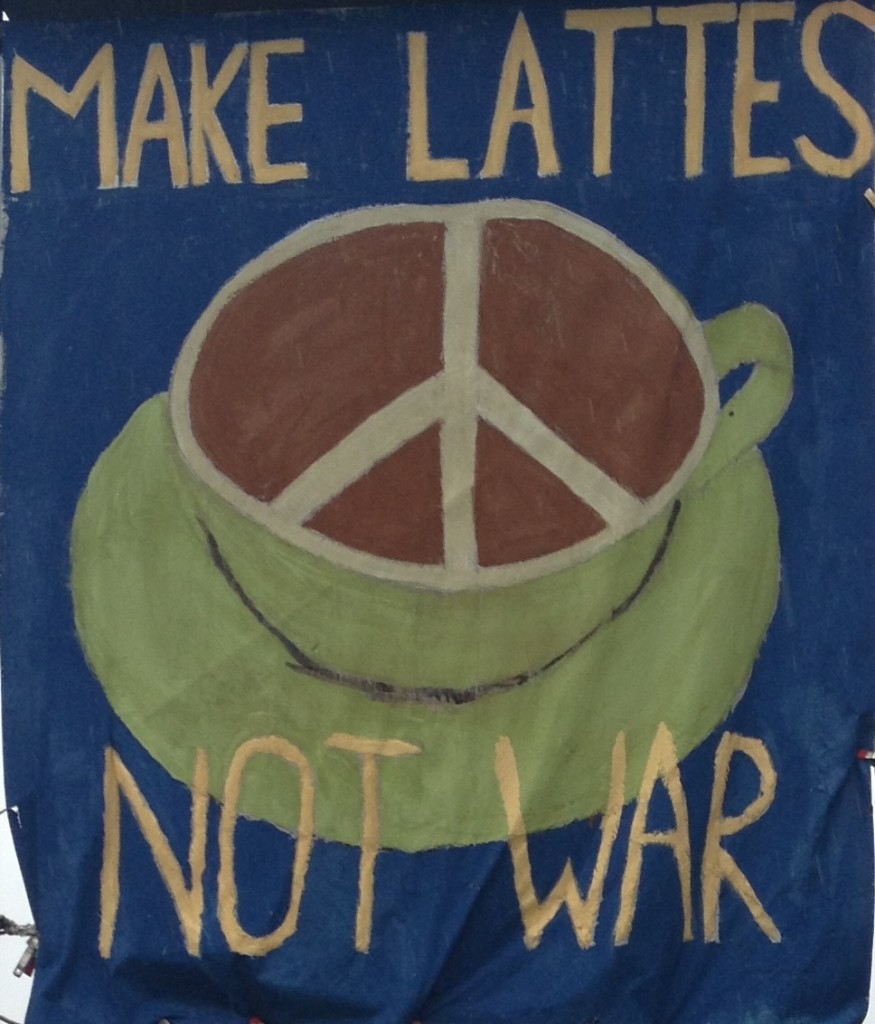Liz: So, tell me about curling. What is it? Why does it involve—
Anastasia: —the brooms?
Liz: Yeah, brooms.
Anastasia: Do you not know anything about curling?
Liz: I think there’s a Norwegian team that has weird pants? That’s what I know. And it shows up on the Olympic schedule. Actually I did see a good analogy for it the other day. Someone said something on Facebook about how curling is like bocce with brooms on ice. And I was like, “I wonder if that’s actually an accurate statement because that’s such an easy way to explain it.” So is it like bocce with brooms on ice?
Anastasia: Do you feel like you understand bocce ball better than you understand curling?
Liz: Yeah, I do.
Anastasia: (Laughs) Um, it is actually kind of like bocce ball on ice, I’m not gonna lie. The whole idea is that you have these giant rocks, that are called “stones”, and you—very similar to bocce ball—are trying to roll them down a large sheet of ice, as opposed to a lane of shells. And you’re trying to have your rocks be the closest to the center of the thingy at the end, which is it called—oh I’m the worst person to do an interview on this—um, fuck what is it called…the button. The middle is called “the button.” The rest of it is called something else, um, it’s like the…target. It’s not the target, but it looks like a target! You’re aiming for that space at the end. So each four person team throws eight stones, two stones per player, and at the end of those sixteen stones, whatever team has the closest rock to this little red thing in the middle, the button, that is the team that gets the points for that “end.” And an end is like one round.
Liz: How many points do you get?
Anastasia: You get as many points as you have stones in the house—the house! That’s what it’s called, the end thingy is called “the house.” The number of stones you have in the house until broken by the other team. [Editor’s Note: Here’s a link because this makes no sense.]
Liz: So why–what are the brooms for? Do you like use them to speed up and speed down? I don’t understand the brooms.
Anastasia: Okay, the brooms. So when you throw a stone, it’s super heavy. Like, I can barely pick up one and carry it. So they are like these super heavy rocks with handles, and you have this thing called “the hack,” which is at the end of your lane of ice, and you basically put one foot in the hack, put a “slider” on your other foot (to make it slippery so you can slide on it), and launch you and your rock down the ice.
Liz: Mhm.
Anastasia: So you launch yourself off the hack and then release the stone turned a little bit to the left or right—that’s called an “in turn” or an “out turn”—and that’s what adds the “curl.” I don’t fully understand the physics, but this controls the direction the rock spins, which affects the way your rock will curl down the ice. And so what the sweeping does is that it can increase the speed that the rock is going or it can help keep the line straight. If you have really good sweepers, the friction that the brooms make warms up the ice, making it slicker, so the rock moves faster. A lot of times, you might release a light stone with the intention of “sweeping it in,” which means that you are going to have your sweepers sweep it really hard to get the most distance out of it. This gives you better control over placement because you can call your sweepers on and off. That’s why you hear all that yelling: the “skip” is telling his/her sweepers to sweep.
Liz: Mhm. Who’s the skip?
Anastasia: So there are four people on each team. The skip is basically the captain. He/she is the last person who throws, usually, and they’re also the person at the end of the lane calling the shots. The skip will tell you which way to turn your rock (so which way to curl—in or out), how much weight to put on your rock (aka how hard to throw it), and tell you where to aim. And then they yell at the sweepers and tell them whether to sweep or not. That’s why they’re yelling things like “hard”—hard means sweep faster, sweep harder—or “off”—off means stop. Stuff like that. When you’re skipping, you have to judge the speed and the “line”—the direction—of the rock to gauge what it’s doing and if that’s what you want it to be doing.
Liz: Um, awesome. Okay, uh-
Anastasia: Does any of that make sense
Liz: Yes. I also read a Wikipedia article as you were saying it and discovered it was like shuffleboard. And then I was like, “Oh!”
Anastasia: Why would you cheat and read a Wikipedia article!?
Liz: Well you were talking about the brooms and I was like, “I don’t… I’m confused.” So I looked it up and then I was like, “Oh! I get it. It’s like shuffleboard with brooms.” And then the brooms made sense.
Anastasia: I like how bocce ball and shuffleboard make more sense to you. I barely understand bocce ball and I’ve never played shuffleboard.
Liz: So where do you go to play? Do you play like at a rink somewhere?
Anastasia: So I play in California. When I started playing, I was playing in northern California, now I play in southern, but before I started, I didn’t even realize that there was any curling out here because it’s a big Canadian and northern sport–and by “nothern” I mean places where it’s actually cold.
Liz: It’s a sport that requires ice and snow.
Anastasia: It does require ice. So you have to play on an ice rink. But I discovered that a lot of ice rinks, at least in northern and southern California, have curling. But it’s not “dedicated ice,” meaning that we curl on the same ice you skate on and that hockey players play on, which is why they call it “arena curling.”
Liz: Is there a difference?
Anastasia: Well, the biggest challenge is dealing with the quality of the ice because you’re sharing it with all these other people. So we’re always kind of dealing with these dips and slopes and drops in the ice, which can really affect the way you throw things. I’ve seen rocks start curling one way and then completely switch directions by the time they get to the house, or make giant s-curves, or hit a bump and lose steam or just stop altogether, it can be really interesting to strategize through.
Liz: So you turn an ice rink into a curling rink?
Anastasia: We take an ice rink, first it gets zambonied, and then we go through and we use this thing—the best way I can describe it is to imagine a swinging Catholic incense urn—that we use to pebble the ice with water droplets. You shake water droplets all over the ice and then run a scraper over them, to clip off the top, which creates this sort of gritty surface. You can walk on it with sneakers and you won’t slip. I mean, it’s still ice, you can slip, and I’ve fallen a couple times while playing, but you can walk on it with your shoes with much less chance of falling. I know a lot of people are intimidated by the ice and say “Oh I’m gonna have to wear skates or I’m gonna fall over,” but I always tell them: all you have to do is wear sneakers and warm clothes. And you don’t have to bundle up cause you’re moving the whole time, so you get hot.
Liz: So who is the best curling team in the world? Like who’s gonna win the Olympics, in your opinion? Or do you not even know? You just like playing?
Anastasia: You know, someone asked me the other day if the Norwegian team was gonna win purely based on their pants–
Liz: (Laughs) I mean, it’s distracting.
Anastasia: I think the Canadians are the best curlers, but I don’t actually know. You know, there’s a lot of people in my league who are really invested in it and in all the tournaments and things. We do these things called Bonspiels, which is like a big curling tournament, and a lot of leagues—um I don’t want to call it leagues, they are actually called clubs, “curling clubs”, I’m in a curling club—they will have Bonspiels. Like we have two in southern California and there’s at least one up in northern California. And so, there is this competitive circuit that goes on and there are curlers who are very invested in it and will travel to different competitions and things, but I haven’t really gotten there. I enjoy watching a good curling match but I’m not—I like playing the sport much more than I like to watch it. So I watch highlights, or the Youtube video of a really epic shot rather than sit and watch a full game or really keep up with who is curling. But I did spend a couple hours educating myself on the Canadian trials and I do think the Canadians are gonna be in medal contention this year.
Liz: Ooh medal contention… Okay, well I guess you already talked about how you ended up playing, but if I—I don’t want to start playing, I’m just gonna let you know—but if I did want to play…
Anastasia: Why not?
Liz: I mean, not to be rude, but is it like, physically hard? Is that a weird question to ask?
Anastasia: (Laughs)
Liz: We were talking about bocce ball and shuffleboard and people kind of consider those retirement, like on the beach, type sports. But clearly curlers are athletes, it’s not a game. But watching it, I’m like, this seems like a game, I don’t understand. And you said the stone’s are really heavy, but what makes it–
Anastasia: It doesn’t seem that physical?
Liz: What makes it physical? Or what does it require physically? Or like, is it something I can pick it up later?
Anastasia: Yeah. I mean, people can curl at all ages. There is an agility factor with the whole sliding thing but there’s actually this hand pole that people can use to release the stone if they can’t, or don’t want to, get down on their knees to slide. But the thing that makes the sport really “athletic” is actually the sweeping. It’s very intense—you’re like running down a sheet of ice and sweeping with as much force as you possibly can while doing it. I mean, it’s not the same physical endurance as say basketball or whatever else. But I would say that it’s probably on par with like softball. I think it’s actually a really good intro sport if you’re kind of out of shape and you’re looking for a fun way to start exercising, because I do think it’s a good workout, but I like it more for the fun of the game than the exercise.
Liz: Yeah.
Anastasia: You, for example, would not be able to replace your running routine with curling.
Liz: Okay. That’s what I wanted to know.
Anastasia: But in terms of starting, you can go online and find out if there is a curling club at your local ice rink. I started with a club in northern California, Wine Country Curling, which I had to drive 90 minutes to get too. Now, in LA, I’m in the Hollywood Curling Club but I’ve also gone down and curled with the O.C. club. Most of these clubs, especially right now during Olympic rush, do tons of “Learn to Curls” and drop ins. That’s how I started, by going to a “Learn to Curl.” It’s very low commitment and it’ll probably cost you $15 to $25. But you’re there for a couple hours and they will teach you all the basics. You will throw stones, you will sweep, you will definitely be able to tell if you like it. I enjoyed it so much I decided to sign up for a league after that. But a lot of clubs will also do “drop in” nights where you can just come and play a game or you can “sub” for a league team, which means you come and fill in for someone who is out that week. And curlers are so, so, so nice. They really want people to learn and everyone is more than happy to teach or answer questions from new curlers. Curling is supposed to be this fun, social activity. So while we do take it seriously, but we have a lot of fun too.
Liz: So, what’s your favorite part of the game? And like, what was the part that took you a long time to understand? Was there something you really struggled with?
Anastasia: The best part of curling is, in my opinion, throwing. Because there’s this moment, when you kick off from the hack, where you’re just kind of floating along on the ice. I love that. You’ve done all this preparation: getting into the hack, making sure you’ve got your slider on, that you’ve got your rock, that you’ve figured out what turn your skip wants you to do, you know where to aim, you know how you need to be positioned to aim there, you know how hard you need to kick off to give the stone the right weight—because the kick off is actually where the force comes from, you don’t launch the rock with your hand, that force comes from your legs—and then, in that moment when you kick off, it’s all done. So it’s this kind of this quiet, calm moment where you are just watching yourself execute. And I think that’s really cool. I don’t really like sweeping, probably because it requires the most physical activity. (Laughs) I also really like skipping. But that was a hard thing for me to grasp–the strategy of it all and really understanding the different ways the rocks turn and where they go and how the curl actually works and the physics of where you want to aim a stone. It took me a whole season before I really started to grasp it, but once I did, it made the game so much more fun.
Liz: Cool.
Anastasia: Now I’m gonna get you to go to a learn to curl.
Liz: No.
Anastasia: I can’t convince you?
Liz: (Laughs) Probably not.
Anastasia Heuer is the founder and Editor-in-Chief of the UNDERenlightened. When she’s not writing, you can find her on the road in search of the world’s best hot chocolate, trying not to burn down her kitchen, or in a park somewhere with a good book.
Liz Bohinc is a Staff Writer for the UNDERenlightened. She’s also a Compassionate Human Being. Runner. Reader. Science Fact and Science Fiction Enthusiast. Softball Addict. Animation Connoisseur. Twitter: @littlelyme.












 Too Much Tweening
Too Much Tweening






